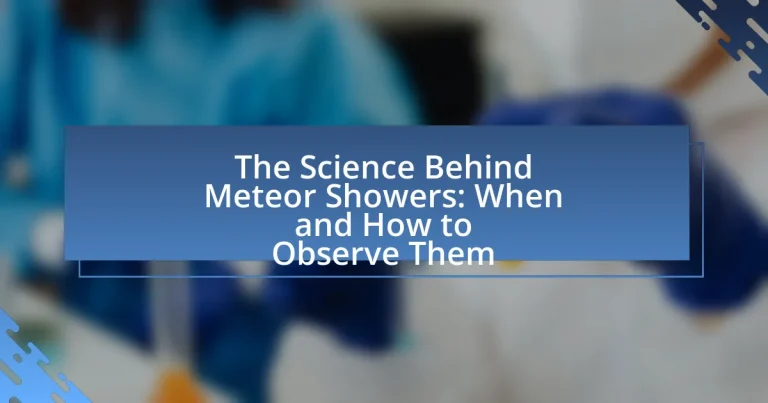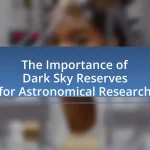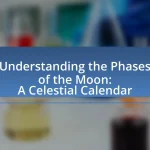Meteor showers are celestial phenomena where numerous meteors, or “shooting stars,” are observed radiating from a specific point in the night sky, typically occurring when Earth passes through debris left by comets or asteroids. This article explores the origins of meteoroids, the mechanics of meteor showers, and their significance in astronomy, including insights into the solar system’s composition and dynamics. It also provides practical guidance on when and how to observe major meteor showers, such as the Perseids and Geminids, detailing optimal viewing conditions and techniques to enhance the experience. Additionally, it addresses challenges like light pollution and weather conditions that can affect visibility during these events.
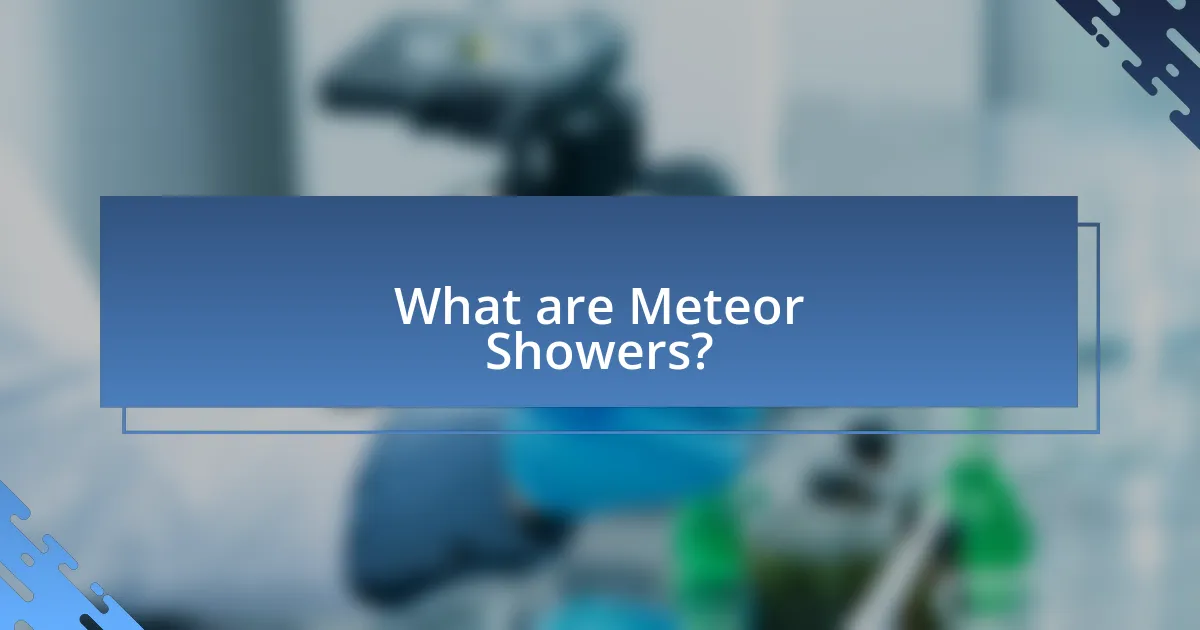
What are Meteor Showers?
Meteor showers are celestial events where numerous meteors are observed to radiate from a specific point in the night sky, typically occurring when Earth passes through the debris left by comets or asteroids. These meteors, often referred to as “shooting stars,” are actually small particles that burn up upon entering Earth’s atmosphere at high speeds, usually ranging from 11 to 72 kilometers per second. The annual Perseids and Geminids are well-known meteor showers, with the Perseids peaking around August 12 and the Geminids around December 14, showcasing the predictable nature of these events based on Earth’s orbit.
How do Meteor Showers occur?
Meteor showers occur when Earth passes through the debris left by comets or asteroids. As these tiny particles, often no larger than a grain of sand, enter Earth’s atmosphere at high speeds, they burn up due to friction with the air, creating bright streaks of light known as meteors. This phenomenon is most visible during specific times of the year when Earth intersects the orbital paths of these celestial bodies, leading to annual meteor showers such as the Perseids and Geminids. The predictable nature of these events is supported by historical observations and astronomical calculations, confirming their occurrence during specific periods.
What are the origins of meteoroids that create meteor showers?
Meteoroids that create meteor showers primarily originate from comets and, to a lesser extent, asteroids. When comets approach the Sun, they shed dust and debris, which forms a trail along their orbit. Earth intersects these trails during its orbit, leading to meteor showers as the particles enter the atmosphere and burn up. For example, the Perseids meteor shower is associated with the comet Swift-Tuttle, which leaves behind a stream of particles that Earth passes through annually. This connection between specific comets and meteor showers is well-documented in astronomical studies.
How does the Earth’s atmosphere interact with meteoroids during a meteor shower?
The Earth’s atmosphere interacts with meteoroids during a meteor shower by causing them to heat up and produce visible light as they enter at high speeds. When meteoroids, typically traveling at speeds between 11 to 72 kilometers per second, collide with the atmosphere, they experience intense friction, which generates heat. This heating causes the meteoroids to vaporize and emit light, resulting in the bright streaks known as meteors. The majority of meteoroids disintegrate before reaching the Earth’s surface, with only a small fraction surviving as meteorites. This phenomenon is observable during meteor showers, which occur when the Earth passes through the debris left by comets or asteroids, enhancing the frequency of meteors visible in the night sky.
Why are Meteor Showers significant in astronomy?
Meteor showers are significant in astronomy because they provide insights into the composition and behavior of celestial bodies, particularly comets and asteroids. When Earth passes through the debris left by these objects, the resulting meteors allow astronomers to study the materials that make up our solar system. For example, the Perseids meteor shower, which occurs annually in August, originates from the comet Swift-Tuttle, enabling scientists to analyze the comet’s composition and activity. Additionally, meteor showers can help refine our understanding of the Earth’s atmosphere and its interactions with space debris, as the meteors burn up upon entry, producing valuable data on atmospheric conditions.
What can meteor showers tell us about the solar system?
Meteor showers can reveal significant information about the solar system, particularly the composition and behavior of comets and asteroids. When Earth passes through the debris left by these celestial bodies, the resulting meteor showers provide insights into the materials that make up these objects, as they often consist of dust and small particles. For example, the Perseids meteor shower originates from the comet Swift-Tuttle, allowing scientists to study the chemical composition of the comet’s remnants. Additionally, the frequency and intensity of meteor showers can indicate the dynamical processes within the solar system, such as gravitational interactions and the evolution of orbits. This information enhances our understanding of the solar system’s formation and the history of its constituent bodies.
How do meteor showers contribute to our understanding of comets and asteroids?
Meteor showers enhance our understanding of comets and asteroids by providing insights into the composition and behavior of these celestial bodies. When Earth passes through the debris left by comets or asteroids, the resulting meteor showers allow scientists to analyze the materials that make up these objects. For instance, the Perseids meteor shower originates from the Swift-Tuttle comet, enabling researchers to study the comet’s dust and gas composition, which reflects its history and evolution. Additionally, the frequency and intensity of meteor showers can indicate the size and distribution of the parent bodies, offering clues about the dynamics of the solar system. This relationship between meteor showers and their parent bodies is supported by observational data and spectral analysis of meteors, which reveal their elemental makeup and origin.
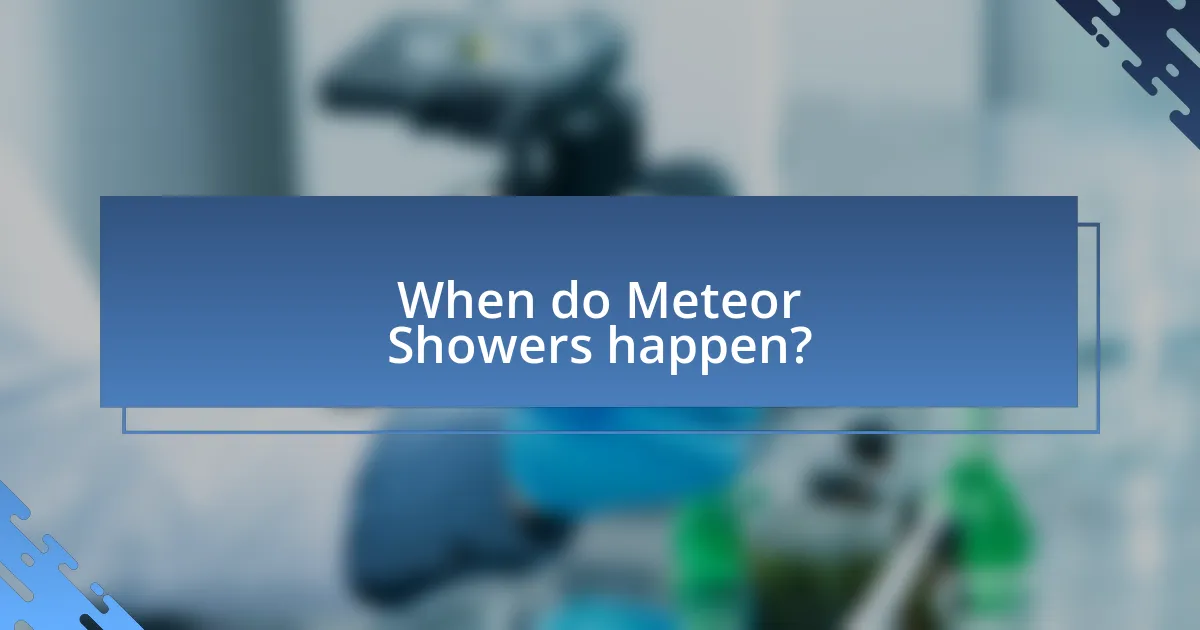
When do Meteor Showers happen?
Meteor showers typically occur at specific times of the year, often associated with the Earth passing through the debris left by comets. For example, the Perseids peak around August 12-13, while the Geminids peak around December 13-14. These events happen annually, providing predictable opportunities for observation. The consistency of these dates is due to the Earth’s orbit around the Sun, which intersects with the trails of debris from these comets at regular intervals.
What are the major meteor showers throughout the year?
The major meteor showers throughout the year include the Quadrantids in January, the Lyrids in April, the Eta Aquariids in May, the Delta Aquariids in July, the Perseids in August, the Draconids in October, the Orionids in October, the Leonids in November, and the Geminids in December. Each of these meteor showers occurs annually and is associated with specific comets or asteroids, providing predictable peaks for observation. For example, the Perseids, which peak around August 12, are linked to the comet Swift-Tuttle and can produce up to 100 meteors per hour under optimal conditions.
When is the peak activity for the Perseids meteor shower?
The peak activity for the Perseids meteor shower occurs annually around August 12th to August 13th. This timing is based on the Earth passing through the debris left by Comet Swift-Tuttle, which produces the meteor shower. Historical observations confirm that the Perseids consistently reach their maximum visibility during this period, making it a prime time for skywatchers to observe the event.
What are the characteristics of the Geminids meteor shower?
The Geminids meteor shower is characterized by its high meteor count, typically producing up to 120 meteors per hour at its peak. This shower occurs annually from December 4 to December 17, with the peak usually around December 13-14. The meteors originate from the asteroid 3200 Phaethon, making the Geminids unique among meteor showers, as most originate from comets. The meteors are known for their bright colors and often leave persistent trails. Observers can expect to see meteors traveling at speeds of about 35 kilometers per second as they enter the Earth’s atmosphere.
How can I find out the best times to observe meteor showers?
To find out the best times to observe meteor showers, consult astronomical calendars or websites that provide specific dates and peak times for each meteor shower event. These resources, such as the American Meteor Society or NASA’s meteor shower page, offer detailed information on annual meteor showers, including their expected peak activity, which typically occurs during specific months. For example, the Perseids peak around August 12-13, while the Geminids peak around December 13-14. Observing during these peak times, especially after midnight when the sky is darkest, enhances the likelihood of witnessing more meteors.
What resources are available for tracking meteor shower schedules?
Resources available for tracking meteor shower schedules include websites like NASA’s Meteor Shower page, which provides detailed information on annual meteor showers, their peak dates, and visibility conditions. Additionally, the American Meteor Society offers a calendar of meteor showers along with observational tips. Mobile applications such as SkySafari and Star Walk also provide real-time tracking and notifications for upcoming meteor showers, enhancing the user experience for stargazers. These resources are reliable and frequently updated, ensuring accurate information for enthusiasts.
How does moonlight affect meteor shower visibility?
Moonlight significantly reduces meteor shower visibility by illuminating the night sky, which diminishes the contrast between meteors and the background. When the moon is full or nearly full, its brightness can overpower the faint light of meteors, making them harder to see. For instance, during the Perseid meteor shower in 2021, a full moon was present, leading to a reported decrease in visible meteors by up to 50% compared to years with darker skies. This effect is due to the moon’s light scattering in the atmosphere, which washes out the visibility of dimmer meteors.
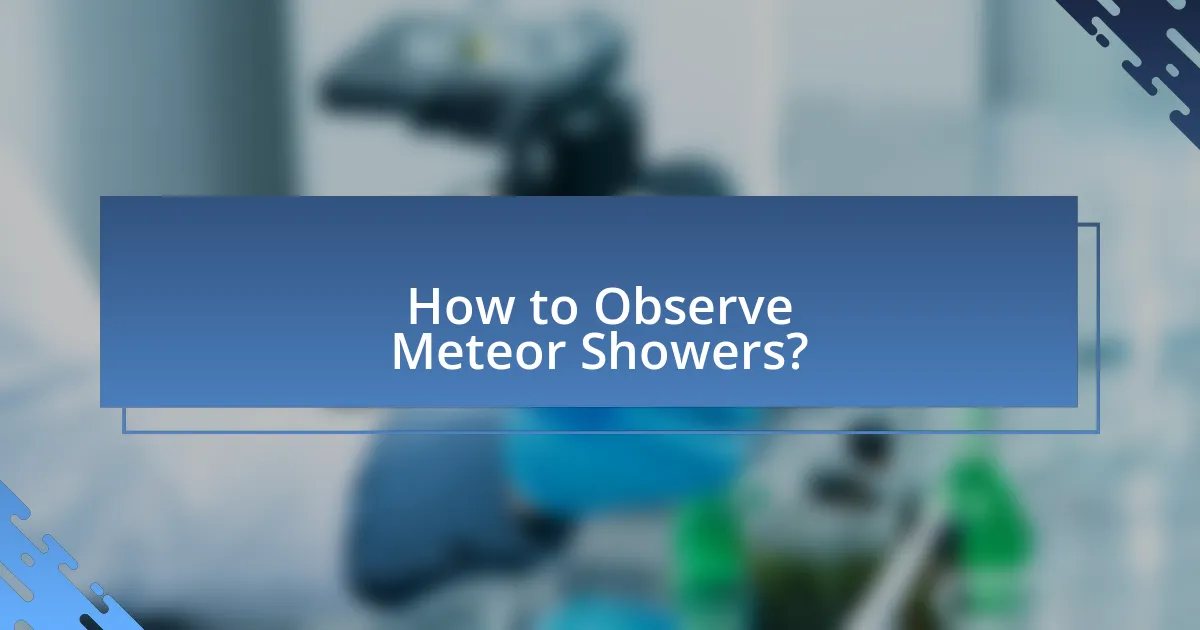
How to Observe Meteor Showers?
To observe meteor showers, find a dark location away from city lights, ideally with a clear view of the sky. During peak activity, which can be predicted based on annual meteor shower calendars, lie back and look up for at least 30 minutes to allow your eyes to adjust to the darkness. The Perseids, for example, peak around August 12-13, while the Geminids peak around December 13-14, with rates of up to 120 meteors per hour. This method is effective because it maximizes visibility and comfort, enhancing the overall experience of watching meteors streak across the sky.
What are the best practices for observing meteor showers?
To effectively observe meteor showers, choose a dark location away from city lights, ideally with a clear view of the sky. This practice enhances visibility, as light pollution significantly diminishes the number of meteors seen. Additionally, timing is crucial; peak activity times, often during the early morning hours, yield the best results. For instance, the Perseids peak around August 12-13, with rates exceeding 60 meteors per hour under optimal conditions. Lying flat on your back allows for a wider field of view, increasing the chances of spotting meteors. Lastly, patience is essential; spending at least 30 minutes observing increases the likelihood of witnessing multiple meteors.
Where should I go to maximize my meteor shower viewing experience?
To maximize your meteor shower viewing experience, go to a location with minimal light pollution, such as national parks or remote rural areas. These locations provide darker skies, which enhance visibility of meteors. For instance, the International Dark-Sky Association identifies places like Big Bend National Park in Texas and Cherry Springs State Park in Pennsylvania as optimal viewing sites due to their low light pollution levels. Additionally, higher elevations can improve visibility, as they reduce atmospheric interference.
What equipment do I need for observing meteor showers?
To observe meteor showers, you primarily need a comfortable spot with a clear view of the sky, a reclining chair or blanket for comfort, and warm clothing to stay cozy during the observation. While no specialized equipment is necessary, binoculars or a telescope can enhance the experience by allowing you to view celestial objects more closely. Meteor showers are best viewed with the naked eye, as they occur in the Earth’s atmosphere and are visible without any optical aids. According to NASA, the best time to observe meteor showers is during their peak, typically late at night to early morning, when the sky is darkest and the meteors are most active.
How can I enhance my meteor shower observation experience?
To enhance your meteor shower observation experience, choose a dark location away from city lights, ideally with a clear view of the sky. This is crucial because light pollution significantly diminishes visibility, making it difficult to see faint meteors. Research indicates that observing from a rural area can increase the number of visible meteors by up to 50%. Additionally, lying on a blanket or reclining chair allows for a more comfortable viewing experience, enabling you to take in a larger portion of the sky without straining your neck. Planning your observation during the peak times of the meteor shower, which can be found in astronomical calendars, will also maximize your chances of witnessing more meteors.
What techniques can improve my chances of seeing more meteors?
To improve your chances of seeing more meteors, choose a dark location away from city lights, ideally with a clear view of the sky. Research indicates that light pollution significantly reduces visibility; for instance, a study by the International Dark-Sky Association highlights that urban areas can diminish meteor visibility by up to 90%. Additionally, timing your observation during peak meteor shower events, such as the Perseids in August or the Geminids in December, increases the likelihood of sightings, as these events can produce up to 120 meteors per hour under optimal conditions. Finally, allowing your eyes to adjust to the darkness for at least 20 minutes enhances your ability to spot faint meteors.
How should I prepare for a night of meteor watching?
To prepare for a night of meteor watching, select a dark location away from city lights to enhance visibility. This is crucial because light pollution significantly diminishes the number of meteors visible to the naked eye. Additionally, check the weather forecast to ensure clear skies, as clouds can obstruct your view of meteor showers. Bring a reclining chair or blanket for comfort, and dress appropriately for the weather to stay warm during the observation period. It is also beneficial to allow your eyes to adjust to the darkness for about 20 minutes, which improves your ability to see faint meteors. According to the American Meteor Society, peak meteor activity can be observed during specific times of the year, such as the Perseids in August and the Geminids in December, making timing an essential factor in your preparation.
What common challenges might I face while observing meteor showers?
Common challenges faced while observing meteor showers include light pollution, weather conditions, and timing. Light pollution from urban areas can significantly hinder visibility, making it difficult to see faint meteors. Weather conditions, such as cloud cover or precipitation, can obstruct the view of the night sky, preventing observation altogether. Additionally, timing is crucial; meteor showers peak at specific times, and missing these windows can result in a lack of visible meteors. According to the American Meteor Society, optimal viewing conditions require dark skies and clear weather, emphasizing the importance of these factors in successful meteor observation.
How can I deal with light pollution during meteor showers?
To deal with light pollution during meteor showers, seek locations with minimal artificial light, such as rural areas or designated dark sky parks. Research indicates that light pollution significantly reduces visibility of celestial events; for instance, a study by the International Dark-Sky Association highlights that urban areas can diminish meteor visibility by up to 90%. Using tools like light pollution maps can help identify optimal viewing spots. Additionally, employing red-filtered flashlights and wearing dark clothing can enhance your night vision, allowing for better observation of meteor showers despite surrounding light pollution.
What should I do if the weather is not favorable for observation?
If the weather is not favorable for observation, you should postpone your observation plans to a later date when conditions improve. Meteor showers are best viewed under clear skies, and poor weather can obscure visibility. Historical data shows that optimal viewing conditions typically occur on nights with minimal cloud cover and low light pollution, enhancing the chances of seeing meteors.
What tips can help me make the most of my meteor shower experience?
To make the most of your meteor shower experience, choose a dark location away from city lights and ensure clear skies for optimal visibility. Dark locations enhance the contrast of meteors against the night sky, allowing for better observation. Historical data indicates that the Perseids meteor shower, for example, can produce up to 100 meteors per hour under ideal conditions, emphasizing the importance of location and weather. Additionally, allowing your eyes to adjust to the darkness for at least 20 minutes will improve your chances of spotting meteors, as your eyes become more sensitive to low light levels.
